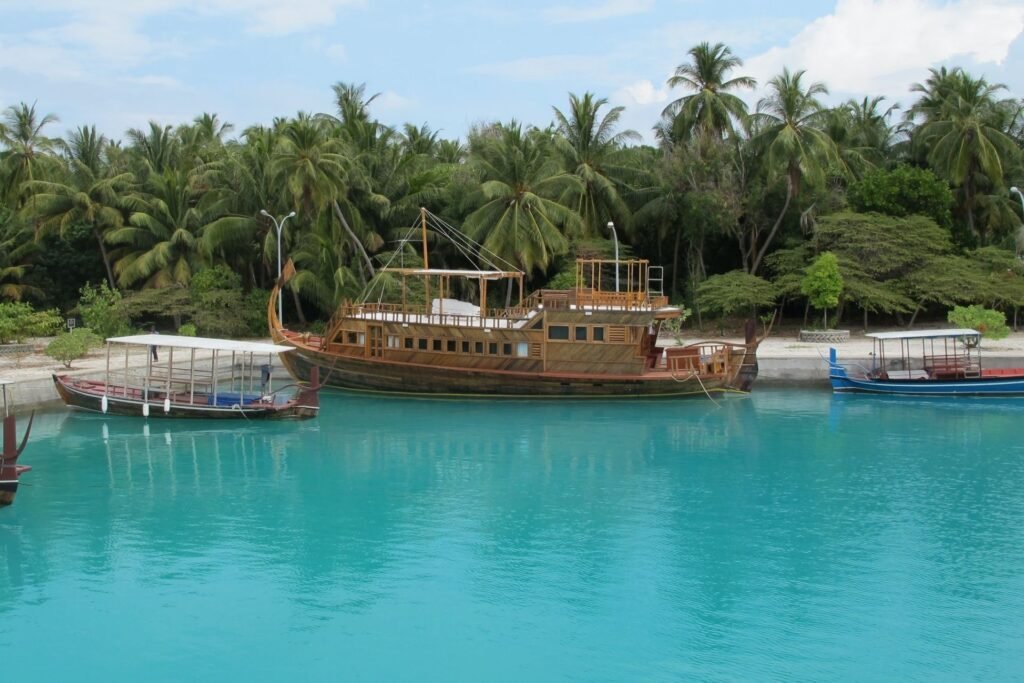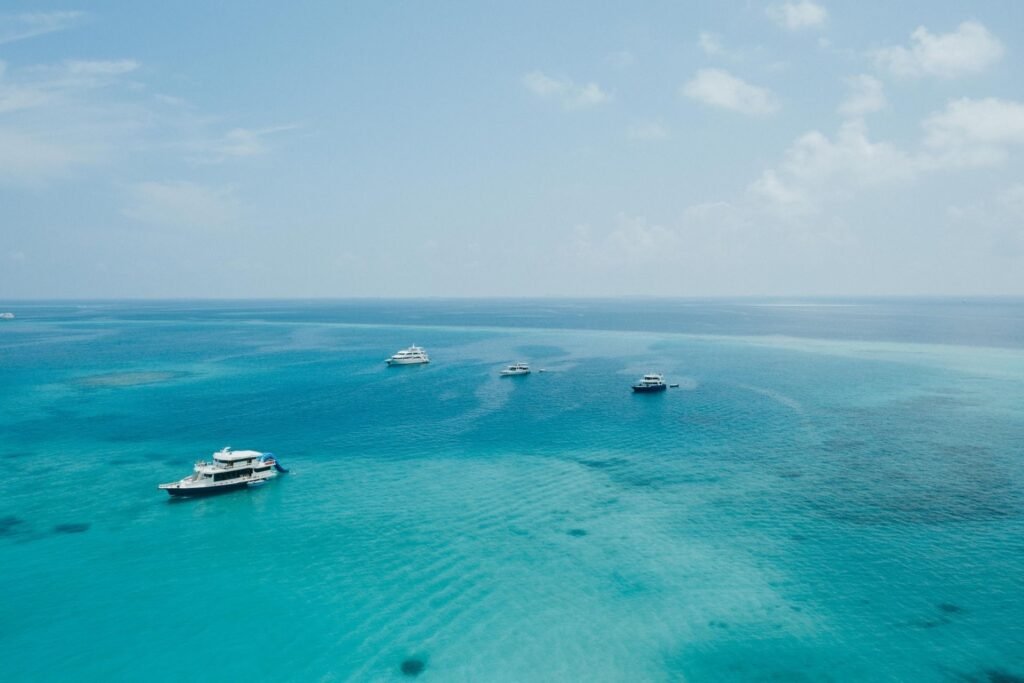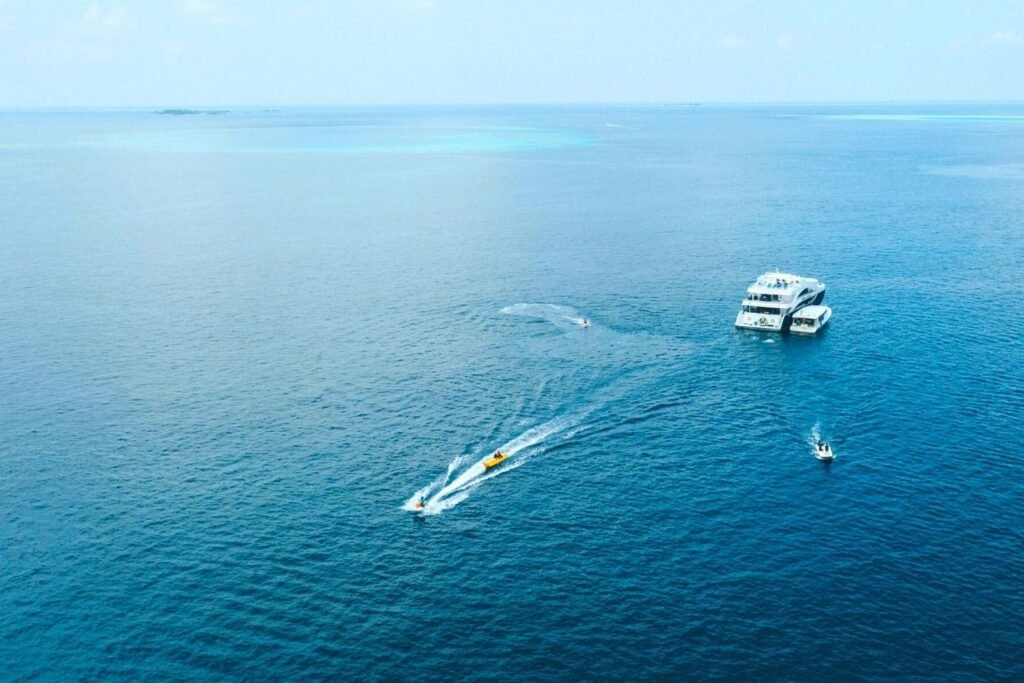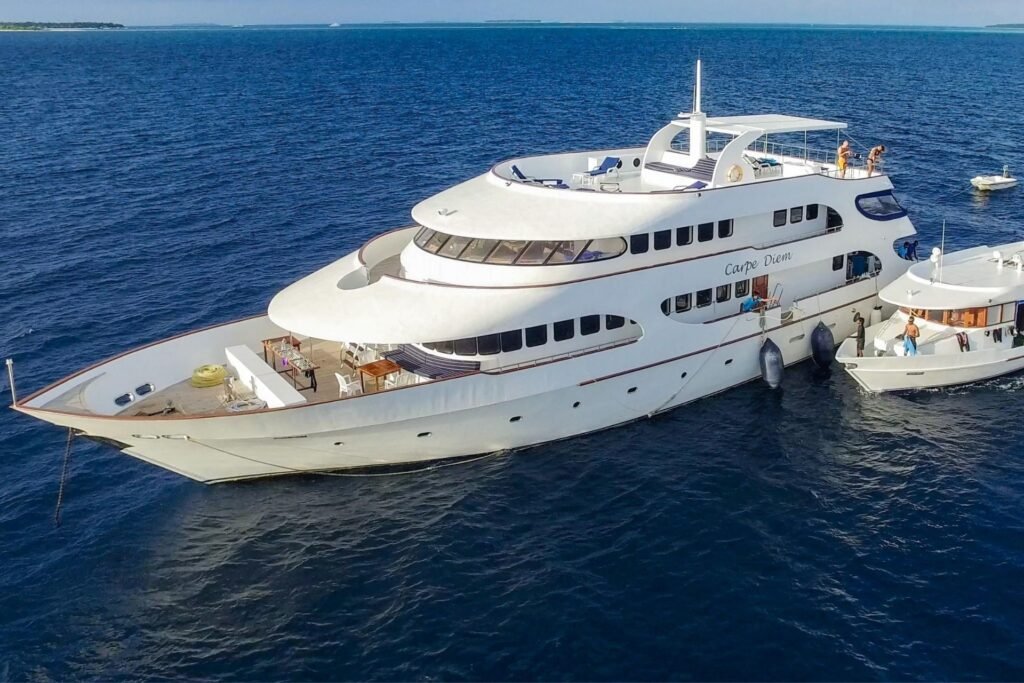Your basket is currently empty!
Liveaboards in Maldives

Imagine living in a floating castle, with all possible luxuries inside, while the waters that surround you seem to be boundless. Enjoy sumptuous meals like royalty, watching distant islands shine like gold over the sapphire blue waters. This imagination can quickly turn into reality if you vacation on liveaboards in Maldives!
When most travellers plan their trip to these scattered little islands, they often think of staying in Maldives’ water villas. But luxury is not limited to the land. You can enjoy an indulgent holiday while cruising for days on end and having similar creature comforts aboard your liveaboard.
What is a Liveaboard?

The term ‘liveaboard’ itself offers a clue to its meaning. Liveaboards are water vessels that can accommodate people for stays that span multiple days. Sailboats that are used for cruising, speedboats and even houseboats often serve as liveaboards, aiding the passengers to use the watercraft as their temporary residence.
Liveaboards in The Maldives are typically used for tourism. A select few Maldives tour packages specialize in sightseeing through liveaboards, often including snorkelling, diving and fishing in the high seas. Liveaboards often dock at different islands for local exploration. However, the night stay is always onboard.
Often confused with luxury cruise liners, liveaboards are very small in size, more like yachts. They typically accommodate 10 to 30 passengers. On the other hand, multi-day cruise vessels are huge ships that have 3 to 15 levels (floors or storeys) and can carry tens of thousands of passengers (including the crew).
Most liveaboards in this archipelago are modern, luxurious and nifty vessels made of steel hulls or plastic that is reinforced with fibre. When you experience the liveaboard lifestyle for a few days, it starts to feel like a never-ending yacht party.
How Much Do Liveaboards Cost in The Maldives?

The daily rate for a liveaboard can start from as little as USD 150 per person and shoot up to USD 400 per person and even more. Considering that liveaboards in The Maldives cruise for at least 5 days and up to half a month, the approximate cost of the total package can range between USD 750 to USD 6,000 for each passenger.
One might be charged additional liveaboard fees to the tune of USD 40 per day to account for diving gear rental. However, Nitrox is generally included in the Maldives vacation packages which are specially curated for diving. Sometimes, a fuel surcharge of USD 10 to USD 15 per day is also levied.
Some other fees to be mindful of when booking a liveaboard holiday in The Maldives is their latest Green Tax of USD 6 per day per tourist. In case your route involves visits to national parks or marine parks in the scattered islands in The Maldives, you can foresee entrance fees that might have to be paid upfront.
Eligibility for Diving Liveaboards in The Maldives
Most activities to do in Maldives don’t generally have any prerequisites, especially for the beginner series. But when it comes to diving liveaboards, some tours require that each participant satisfies their internal criterion of minimum logged dives.
While a couple of liveaboards have no minimum threshold of logged dives, the typical requirement ranges from 20 logged dives to 100 (for very advanced routes over long durations). Check dives are conducted in Malé on the first day of the liveaboard tour.
It is recommended to bring your own dive computer, mask, fins and booties even though the liveaboard tour provider might be able to let you rent those. Well fitting gear results in more enjoyable and comfortable dives.
Best Time of the Year to Visit The Maldives on a Liveaboard
Maldives’ weather is what makes this tropical paradise the dreamy place it is. The country is blessed with sunny days almost all round the year. However, it is better to avoid the monsoon months of April through October. When you go on a diving holiday and spend your days on a liveaboard, it bodes well to plan ahead and ensure you have the best visibility by giving the rains a miss.
Expect the land temperatures to hover around a pleasant 24 degrees Celsius to 33 degrees Celsius while the water offers a comfortable 26 to 30 degrees Celsius to dive into. It might seem a bit chilly when you first step into the ocean for the day and if you sit in your wetsuit on the deck while the yacht sails at great speeds.
For this reason, a full body warm wetsuit is recommended, especially those with temperature control and sun protection. The Maldivian islands are distributed on either side of the equator, making the sunrays particularly strong in this part of the planet.
Check this detail guide on the best time to visit the Maldives.
Liveaboard Routes & Departure Points in The Maldives

A number of exciting sea routes are taken by different liveaboard operators in The Maldives. Malé – capital city of The Maldives is where most liveaboards begin their journey from. Arriving here is as easy as catching a flight to the Velana International Airport on Hulhulé Island.
You won’t even have to switch any modes of transportation as the main departure port for liveaboards is right on this isle! Each liveaboard route has something special to offer. Some of the most interesting ones are as under.
Ari Atoll Liveaboards

Liveaboards that cruise in the Ari Atoll, part of the Central Atolls, allow for diving in waters that are home to submerged volcano lookalikes. Large sized marine species can be spotted near these underwater peaks. This atoll extends across 40 km, helping divers sight whales, pelagic fish, whale sharks and manta rays. It is possible to tender at sea or dock at any of the 105 little islands that form Ari Atoll. Some of the most sought after dive sights are so remote that only liveaboards can get you that far.
Liveaboard routes often include Donkalo Thila which is a manta ray cleaning station where they gather in huge numbers for a few hours every day. This is where smaller marine organisms such as cleaner wrasse and parasitic copepods clean up the teeth, skin and gills of these manta rays. Maaya Thila is another dive site, counted among the premier ones in The Maldives for its flourishing reef ecosystem.
December to May are the best months for dives in Ari Atoll as that is when the sea is calm and the visibility is good, up to 15 to 20 metres. Liveaboard journeys last a week or two in and around this atoll, the itinerary often including the nearby atolls of Baa, Rasdhoo (for the striking hammerhead sharks), North Malé and South Malé.
The liveaboards generally used for Ari Atoll cruises are luxurious MV yachts. It is required to have significant diving experience, preferably 50 logged dives to be able to navigate the strong currents around this atoll. It bodes well to remember that it is these very currents that bring manta rays, Dolphins and whale sharks to Ari Atoll.
Laamu Atoll Liveaboards

Located in the Southern Atolls, Laamu Atoll is a relatively unexplored one, with no resorts in sight. The atoll stretches across 48 kilometres, and the liveaboards that venture here give you the rare opportunity to dive where no man has gone before!
While the outer reefs of Laamu almost never see any divers, its deep channels offer spaces to view very large schools of fish. You can witness a depth of 70 metres at some lagoons where there is a high concentration of fish biomass.
Expect to see tuna and jacks whizzing past you. It is possible to watch eagle rays and white tip reef sharks if you drift dive in these channels or kandus as they are known in Dhivehi – local language of The Maldives.
Baa Atoll Liveaboards

Part of the Northern Atolls, Baa Atoll offers a treasure trove of marine species and undersea landscapes to be explored. The topography is considered to be interactive and also doable for beginners, especially at places where the currents are moderate.
Baa Atoll liveaboard itineraries mostly start from Malé – the world’s smallest capital, but one can also begin their tour from Hanimaadhoo. Take a domestic seaplane from Malé International Airport to arrive on this local island in the North.
Treat your eyes to an amazing variety of fish and corals as you book your liveaboard itinerary in Baa Atoll. Spanning at least 7 days and lasting up to 10, the dive cruises attempt to acquaint you with the pinnacles, kandus and overhangs of this part of the Indian Ocean.
Head to the World Biosphere Reserve at Hanifaru Bay to watch mantas and whale sharks devouring planktons. August through November are the best months to watch this busy activity as that is the plankton-rich season. However, May until December offer decent sightings as well. Keep in mind that the seas can be a bit rough during the monsoon, which usually descends here in May and lasts until November.
Maavaru Kandu is a beautiful underwater channel that houses soft corals in an array of colours such as yellow, blue and green. Swim through the kandu and admire the rocky overhangs, coral gardens and fish biomass.
Be enraptured by the whip corals at Dhonfanu Thila or the bushy black corals at Dhigali Haa in Baa Atoll. It is also possible to sight the abundant manta rays, schooling snappers and sea fans here. If your liveaboard tour is a longer one, you might be taken to the nearby more pristine atolls of Lhaviyani, Raa or Noonu as well.
South Malé Atoll Liveaboards

Offering visibility of up to 30 metres, liveaboard cruises in the South Malé Atoll are super convenient. The dives generally happen via dive dhonis – traditional Maldivian wooden boats that ferry you from your luxury yacht to the dive spot.
One of the Central Atolls, South Malé Atoll is a relatively busy one since it is here that most of the luxury private island resorts in The Maldives are located. Interestingly, just three of the islands in this atoll are inhabited islands where the local Maldivian population dwells.
The channels that link the outer open ocean to the interior part of the atoll are often called kandu in the local dialect. Six of these kandus act as pathways to strong currents that are basically fish magnets for the nutrients they bring in.
Large-sized schooling fish, other types of pelagic fish and reef sharks are spotted in great numbers when you go on liveaboard diving trips here. Appreciate the soft corals that appear in an astounding variety of colours in this destination that is otherwise known as a reef premier shark area.
Liveaboard itineraries in South Malé are plentiful, with lots to see and photograph. Keep your underwater camcorders handy or travel with a nifty GoPro with a stabilizing gimbal to get your videos right.
For drift experts, Embudhoo Kandu is a top choice as this dive site is home to narrow canyons, underwater mountains or thilas as they are locally known, and caves. The dive requires some drift experience to cover the huge distance in that current which includes passing through a sharp drop and navigating canyons.
Undersea encounters in this protected marine area include grey reef sharks and white tip sharks which are the primary candidates for conservation. You will also sight big-sized groupers, Napoleon wrasse and rays.
Located in the northeast of South Malé Atoll, Embudhoo Kandu has a gorgeous coral-studded mountain. Since you will reach the bottom of the ocean, you will be able to spot benthic organisms and reef-dwellers such as filter feeders.
Beginners can take a look at the Kuda Giri shipwreck site which will set your Instagram feed on fire! Insanely popular with photographers and posers who like underwater themes, this dive site has a small ship that has been sunk on purpose.
This has led to the creation of an artificial reef, attracting benthic animals such as sponges. Over time, corals have grown and multiplied over the hull of the ship, making it look surreal. After you are done taking pictures, gape at the glassfish and batfish that have come to reside here permanently.
Other routine visitors include turtles, Napoleon wrasses and bigger reef organisms. Divers will also be able to explore a pinnacle close to the Kuda Giri Wreck where there is a chance to spot octopuses, nudibranchs and other reef species.
A dive site which should not be missed in the Central Atolls is Guraidhoo Kandu South. This large region requires multiple dives, and is highly suited to those on liveaboard holidays. Offering both vertical and horizontal relief features, this site is home to a reef flat and a couple of channels.
Float through caverns, dive down walls, drift across channels and slide alongside slopes deep in the ocean. Witness an open-ocean surprise of pelagic fish after a particular drift diving session that lasts for 300 metres. If you get tired in the way, you can rest in the small caves that appear on the walls of the canyon.
Admire the breathtaking black coral bushes that lie over the rocky topography of Guraidhoo Kandu South. You can also document the details of other soft corals in different colours through photographs and annotations. Expect to see sharks and wrasses as well.
With a well-timed dive at Cocoa Thila, you will be able to view flabbergasting marine fish such as jacks, sweetlips, tuna, groupers, eagle rays, snappers and sharks. Liveaboard dive guides need to be experts at planning the dive schedule on this submerged mountain as extremely strong currents can prevent any dives happening. On the other hand, when the sea is calm, with virtually no underwater currents, the fish activity will also be negligible.
Another underwater pinnacle worth exploring is Kandooma Thila. Regarded as one of the best in South Malé, this dive spot will teach you loads about the diet of various fishes. Watch the schooling barracudas or predatory reef fish such as snappers and groupers hidden in the holes of the thin channel walls.
Observe how the jacks feed on brightly coloured anthias and reef sharks swim close to the rocky surface of the pinnacle. Water currents can get quite strong here, so diving experience is mandatory.
North Malé Atoll Liveaboards
Although not as popular as South Malé Atoll, North Malé Atoll makes up for its slightly lower popularity with its better level of marine ecology preservation. Sightings in this Central Atoll include a balanced encounter with manta rays, reef sharks and both soft and hard corals.
Liveaboard routes almost always include a stop at Manta Point. Abundant in cleaning stations, this dive point is rich in wrasses which help in removing the parasites off mantas. A myriad manta rays are on display at this busy junction located above a shallow coral reef.
Apart from manta rays that wait in a queue for their turn at getting cleaned, at Manta Point you will also find eels, reef sharks and critters on the slopes. On certain occasions, turtles and Napoleon wrasses can also be spotted.
Rainbow Reef or Girifushi Thila stands right at the top of all dive sites in North Malé Atoll. Located off the shore of Himmafushi Island, this dive site can show you ethereal scenes up to a depth of 12 metres. Be mesmerized by the soft corals that seem to oscillate as the currents pass by them.
Girifushi Thila offers a significant number of overhands and cracks along its submerged walls for divers to rest from the strong drift-inducing currents. As you take refuge, you can watch beautiful schools of jacks, reef sharks, tuna and eagles rays.
One of the first discovered dive sites in this atoll, Banana Reef attracts visitors with its branching corals. Named after its banana-shaped reef, this dive site houses large sea fans and soft corals along its curve. One can also find morays and giant groupers hiding in the vibrant corals here.
Explore deeper and farther to come across false moorish idols which seem to be stuck in the current. The currents are very strong, earning them the moniker of ‘Washing Machine’. Hence divers are advised to maintain distance from these bannerfish and watch the action from afar. The diving experience will be memorable though, thanks to intriguing caverns that frame the topography of Banana Reef.
Grab the opportunity to see a real shipwreck (and not an artificial one like the Kuda Giri Wreck in South Malé) when you visit Victory Wreck. Hang on to the descent line firmly as you begin the dive since the currents are quite strong here.
Measuring 83 metres in length, Maldive Victory was a Singaporean cargo ship that was shipwrecked while on its way to Malé from Singapore. The ship sank in 1981 but today, it offers a lovely spot for recreational diving and underwater photography, thanks to the nice visibility down here.
Almost 40 years since the shipwreck incident this sunken cargo ship has been colonized by undersea creatures, forming a breathtaking artificial reef. Liveaboard tours in North Malé always include this dive site in the itinerary. From macro-critters, nudibranchs and big fish residing permanently here to corals reproducing along the bow of the ship, there is plenty to watch. Do not miss the pufferfish, large groupers or ghost pipefish that are routinely spotted at Victory Wreck.
The Best Maldives Liveaboards
Some of the well known liveaboards in The Maldives are
- Air Queen
- Eco Blue
- Princess Haleema
- Emperor Explorer
- Blue Voyager
- Carpe Diem
- Blue Force One
- Scubaspa Ying
- Nautilus One
Expect to live in a floating luxury hotel when you get onboard any of these liveaboards.
While almost all liveaboards offer air-conditioned en-suite private cabins with contemporary amenities, furnishings and design, some go the extra mile with hot tubs, spa and massage services, Jacuzzi and parlours. You might also be able to access al-fresco and indoor dining areas, bars, lounges and sundecks to unwind after those long dives.
It is hard to think of any tropical holiday here without Maldives’ resorts on water. However, liveaboards offer an experience more exclusive than anything else you have ever heard or read about. Book activities in Maldives with Samudra Maldives to create memories that will last forever.